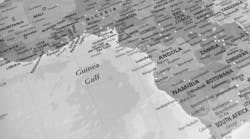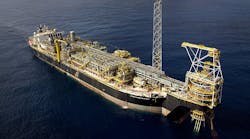Following its exploration successes off Rio Muni in Equatorial Guinea last fall, Triton Energy is pressing ahead with a development based on a 2 million bbl floating pro duction, storage, and offloading (FPSO) vessel. First oil from the project could be produced by year-end.
Dallas-based Triton has budgeted $90 million for the development, excluding the FPSO, which will likely be leased. This vessel will have an initial producing capacity of 60,000 b/d, expandable over the longer term to 240,000 b/d
Aside from transforming Triton's global production profile, the project has implications for the West African petroleum industry as a whole, according to Edinburgh-based analysts Wood Mackenzie:
- The two Ceiba discovery wells, in 700 meters of water, demonstrate the nascent prowess of independents in deepwater drilling.
- The discovery likely will open a new deep water exploration fairway, stretching from Cameroon to Gabon.
- Potentially, it could establish Equatorial Guinea as the Saudi Arabia of West Africa, in terms of per capita oil wealth.
Hitherto, this tiny state of less than 500,000 inhabitants had depended on Mobil to stoke its fast-growing economy. Production from Zafiro fields (onstream since August 1996) has prodded the nation's GDP from $120 million in 1994 to $700 million last year. With the new Jade platform due to be commissioned on the Zafiro fields this year, production could climb to 118,000 b/d. If Ceiba is fast-tracked - and Zafiro remains on plateau - national output could soar to 180,000 b/d by 2003.
Drilling history
Rio Muni on mainland Equatorial Guinea is situated 150 miles south of the capital, Malabo. Prior to Triton's recent campaign, the area had been largely overlooked. Gulf drilled two dry offshore wells in 1968 and 1971, while Elf had little to show either from three further wells between 1986-91. Subsequently, BHP and Enterprise held a license until 1995, but elected not to drill, blaming border disputes with neighboring Gabon.
Two years later, Triton signed up to new production sharing contracts (PSC) for adjacent blocks F and G over 5,300 sq km in the Rio Muni Basin. Each license carried a commitment to drill one well during the first two years. However, it then gained a one-year extension in order to find a partner to share the drilling costs. Last October, Cape Town-based Energy Africa was brought onboard as a 15% participant.
Triton had begun its exploration effort on the blocks in late 1997, acquiring 2,500 km of 2D seismic as well as magnetic and gravity data. The Ceiba-1 exploratory well was spudded around 22 miles offshore in Block G in late August. This encountered a 225-meter gross oil column with net pay of 95 m in four zones, with one 50-meter interval testing 12,400 b/d of 30° API oil. Test flow was constrained by surface testing equipment capacity. Triton has since estimated that 20,000 b/d could be achieved from the well following completion.
Appraisal well Ceiba-2 was drilled immediately afterwards, a mile to the southwest and 194 ft downdip of Ceiba-1. This well encountered 300 ft net oil pay in a single continuous column. It also confirmed the oil-water contact found in the first well, and demonstrated lateral reservoir continuity and connectivity. Total depth was around 8,740 ft. Flow tests were considered unnecessary. A similar production rate to that of Ceiba-1 is expected, following completion.
According to Wood Mackenzie, the sandstone reservoirs are of late Cretaceous age, with typical porosities of 20-25%, and with permeability ranging from 100 mD up to several Darcies. The trapping mechanisms may be partially stratigraphic.
Both wells drilled to date will soon be completed as subsea production wells for connection to the FPSO through flowlines. The partners plan to drill
and complete two further appraisal/ production wells during the course of the year. The location for these wells will be determined partly from an expanded 4,200 sq km 3D seismic acquisition program currently underway.
This is intended to aid delineation of Ceiba's full extent, but will also be used to identify exploration prospects in other prospective areas of the licenses. The survey is due to be concluded for subsequent evaluation in the last quarter of 2000.
Ceiba's reserves are put conservatively at over 100 million bbl, with potential upside of over 500 million bbl. Deploying an FPSO would minimize upfront capital expenditures (capex), allowing the partners to resist co-opting a third party with greater financial muscle later on. However, any such attempts may have been thwarted anyway by the counter-attractions of the government's latest licensing round. This covered all available acreage offshore Equatorial Guinea, including 40 blocks beyond the 200-meter isobath.
The overall producer response was slow, due largely to low oil prices at the time. Following Triton's discovery, more would-be entrants can now be expected, either through farm-ins or through lodging direct applications. However, the government's own expectations also may have risen, which may lead in turn to lengthier license negotiation periods.
Latent prospects
Interest could also rally in a deepwater corridor stretching north and south. Off Sao Tome & Principe, Mobil holds the sole petroleum license - a technical assistance agreement covering offshore blocks 1-22. This parcel extends over 48,000 sq km of largely ultra-deepwater acreage, including an area adjacent to Rio Muni's maritime frontier. Mobil lately has been interpreting results of a 2D seismic survey, but must decide by May whether to solicit a full-blown exploration PSC.
Below Rio Muni, offshore northern Gabon has also been largely neglected. Arco drilled two deepwater wells north of the Port Gentil trough, one of which yielded minor oil shows. Recently, Santa Fe Snyder signed up for Agali, Gabon's northernmost deepwater block. The Gabon government plans to offer more deepwater tracts this year under its 9th licensing round.
Around 50 km north of Ceiba are the MLHP-1 and MLHP-2 deepwater blocks in Cameroon's waters, opened by the government there last September as part of its 3rd Petroleum Licensing Round. They lie within the Douala/Kribi-Campo Basin, which is separated from the Rio Muni Basin by the Campo/Pongue high. March 31 is the proposed closing date for this round, which incorporates allegedly more attractive licensing terms based on a new petroleum law.
The shallow water section of the Douala/ Kribi-Campo Basin contains several hydrocarbon discoveries, the largest being the Sanaga Sud gas and condensate field. The Kribi permit, operated by Perenco, includes several oil and gas fields such as Kribi F, which has been developed via a mobile production vessel (MOPU) linked to a moored tanker loading and storage facility.
The two available deepwater blocks extend over 2,400 sq km in total, over water depths of 200-2,000 meters. Western Geophysical shot 1,200 km of 2D seismic over this area in 1998, the eastern boundary of which lies 50 km from the Kribi port and existing oil export services.
According to Cameroon's Societe Nationale des Hydrocarbures, the main play type in the deepwater blocks comprises Upper Cretaceous and Lower Tertiary sand developments in stratigraphic traps within basin floor and base-of-slope fans, sourced by underlying lower to mid-Cretaceous oil-prone source rocks. "In most cases," the 3rd Round report states, "these are well defined on seismic data with a characteristic morphology and internal reflection geometries. A number of such fan/mound features have been delineated in the deepwater area by the new seismic data. Another stratigraphic play-type is formed by a north-south channel system developed longitudinally along the paleo-shelf edge.
"To charge reservoirs developed in Upper Cretaceous to Tertiary section from source rocks in the lower to mid-Cretaceous necessitates vertical migration. Fault or fracture conduits are provided in localized areas by differential movement over deep transforms or through-going strike-slip faulting. A deepwater structural play is also provided by a major east-west trending strike-slip fault which has transpressionally deformed the sedimentary section up to base Miocene level.
"The oil and gas fields to the east of the deep water area occupy structural traps formed during the Santonian gravity-slide tectonic episode. As such they are dependent on hydrocarbon charge from late-matured older and deeper source rocks in the deepwater kitchen area to the west."
For more information on the Republic of Cameroon Licensing Round, contact either Jean-Jacques Koum of SCH (Tel: + 237 201910) or Richard Bray of Exploration Consultants in the UK (Tel: +44 1491 415400).
Triton goes for second rig
Triton has decided to fast-track its already fast-tracked program for Ceiba. The company had previously planned a single-rig program, but with the government approval it has decided to implement a two-rig drilling program. The new program calls for up to ten wells, specifically:
- Completion as oil producers of the Ceiba-1 and -2 wells, previously drilled.
- Drilling and completion of two Ceiba Field appraisal/production wells, Ceiba-3 and Ceiba-4.
- Drilling of two exploration wells, one each on Blocks F & G.
- Drilling options for a combination of up to six additional development, appraisal and/or exploration wells.
Drilling operations are scheduled to begin in April with the Ceiba-3 appraisal well with the second rig scheduled to arrive in late May and begin completion operating on the Ceiba-1 and Ceiba-2 wells. Triton is in contract talks with drilling contractors and expects to finalize a commitment shortly.




